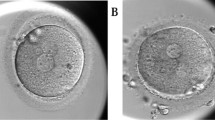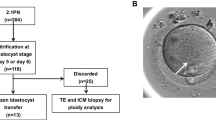Abstract
Purpose
This study aimed to derive heteroparental normal karyotypic human embryonic stem cells (hESCs) from microsurgically corrected tripronuclear (3PN) zygotes.
Methods
After sequential culture for 5–6 days, embryos developed from microsurgically corrected 3PN zygotes were analyzed by fluorescence in situ hybridization (FISH) using probes for chromosomes 17, X and Y. Intact 3PN zygotes from clinical in vitro fertilization (IVF) cycles were cultured as the control group. The inner cell mass (ICM) of blastocysts that developed from microsurgically corrected 3PN zygotes was used to derive hESC lines, and the stem cell characteristics of these lines were evaluated. G-banding analysis was adopted to identify the karyotype of the hESC line, and the heteroparental inheritance of the hESC line was analyzed by DNA fingerprinting analysis.
Results
The blastocyst formation rate (13.5 %) of the microsurgically corrected 3PN zygotes was significantly higher (P < 0.05) than that of intact 3PN zygotes (8.7 %). The diploid rate of the blastocysts (55.0 %) was significantly higher (P < 0.05) than that of the arrested cleavage-stage embryos (18.4 %) in microsurgically corrected 3PN zygotes. The triploid rate of the microsurgically corrected 3PN zygotes (5.7 %) was significantly lower (P < 0.01) than that of intact 3PN zygotes (19.4 %). Furthermore, we established one heteroparental normal karyotypic hESC line from the microsurgically corrected tripronuclear zygotes.
Conclusions
Pronuclear removal can effectively remove the surplus chromosome set of 3PN zygotes. A combination of pronuclear removal and blastocyst culture enables the selection of diploidized blastocysts from which heteroparental normal karyotypic hESC lines can be derived.




Similar content being viewed by others
References
Pieters MH, Dumoulin JC, Ignoul-Vanvuchelen RC, Bras M, Evers JL, Geraedts JP. Triploidy after in vitro fertilization: cytogenetic analysis of human zygotes and embryos. J Assist Reprod Genet. 1992;9:68–76.
Rosenbusch BE. Selective microsurgical removal of a pronucleus from tripronuclear human oocytes to restore diploidy: disregarded but valuable? Fertil Steril. 2009;92:897–903. doi:10.1016/j.fertnstert.2008.07.1740.
Porter R, Han T, Tucker MJ, Graham J, Liebermann J, Sills ES. Estimation of second polar body retention rate after conventional insemination and intracytoplasmic sperm injection: in vitro observations from more than 5000 human oocytes. J Assist Reprod Genet. 2003;20:371–6.
Kang HJ, Rosenwaks Z. Triploidy—the breakdown of monogamy between sperm and egg. Int J Dev Biol. 2008;52:449–54. doi:10.1387/ijdb.082602hk.
Plachot M, Crozet N. Fertilization abnormalities in human in-vitro fertilization. Hum Reprod. 1992;7 Suppl 1:89–94.
Staessen C, Van Steirteghem AC. The chromosomal constitution of embryos developing from abnormally fertilized oocytes after intracytoplasmic sperm injection and conventional in-vitro fertilization. Hum Reprod. 1997;12:321–7.
Grossmann M, Calafell JM, Brandy N, Vanrell JA, Rubio C, Pellicer A, et al. Origin of tripronucleate zygotes after intracytoplasmic sperm injection. Hum Reprod. 1997;12:2762–5.
Golubovsky MD. Postzygotic diploidization of triploids as a source of unusual cases of mosaicism, chimerism and twinning. Hum Reprod. 2003;18:236–42.
Rosenbusch BE. Mechanisms giving rise to triploid zygotes during assisted reproduction. Fertil Steril. 2008;90:49–55. doi:10.1016/j.fertnstert.2007.06.031.
Zaragoza MV, Surti U, Redline RW, Millie E, Chakravarti A, Hassold TJ. Parental origin and phenotype of triploidy in spontaneous abortions: predominance of diandry and association with the partial hydatidiform mole. Am J Hum Genet. 2000;66:1807–20. doi:10.1086/302951.
McFadden DE, Robinson WP. Phenotype of triploid embryos. J Med Genet. 2006;43:609–12. doi:10.1136/jmg.2005.037747.
Berkowitz RS, Goldstein DP. Clinical practice molar pregnancy. N Engl J Med. 2009;360:1639–45. doi:10.1056/NEJMcp0900696.
Rawlins RG, Binor Z, Radwanska E, Dmowski WP. Microsurgical enucleation of tripronuclear human zygotes. Fertil Steril. 1988;50:266–72.
Gordon JW, Grunfeld L, Garrisi GJ, Navot D, Laufer N. Successful microsurgical removal of a pronucleus from tripronuclear human zygotes. Fertil Steril. 1989;52:367–72.
Malter HE, Cohen J. Embryonic development after microsurgical repair of polyspermic human zygotes. Fertil Steril. 1989;52:373–80.
Palermo G, Munne S, Cohen J. The human zygote inherits its mitotic potential from the male gamete. Hum Reprod. 1994;9:1220–5.
Ivakhnenko V, Cieslak J, Verlinsky Y. A microsurgical technique for enucleation of multipronuclear human zygotes. Hum Reprod. 2000;15:911–6.
Escriba MJ, Martin J, Rubio C, Valbuena D, Remohi J, Pellicer A, et al. Heteroparental blastocyst production from microsurgically corrected tripronucleated human embryos. Fertil Steril. 2006;86:1601–7. doi:10.1016/j.fertnstert.2006.04.047.
Gu Y-F, Lin G, Lu C-F, Lu G-X. Analysis of the first mitotic spindles in human in vitro fertilized tripronuclear zygotes after pronuclear removal. Reprod BioMed Online. 2009;19:745–54.
Kattera S, Chen C. Normal birth after microsurgical enucleation of tripronuclear human zygotes: case report. Hum Reprod. 2003;18:1319–22.
Gardner DK, Schoolcraft WB. No longer neglected: the human blastocyst. Hum Reprod. 1998;13:3289–92.
Jones GM, Trounson AO, Gardner DK, Kausche A, Lolatgis N, Wood C. Evolution of a culture protocol for successful blastocyst development and pregnancy. Hum Reprod. 1998;13:169–77.
Thomson JA, Itskovitz-Eldor J, Shapiro SS, Waknitz MA, Swiergiel JJ, Marshall VS, et al. Embryonic stem cell lines derived from human blastocysts. Science. 1998;282:1145–7.
Reubinoff BE, Pera MF, Fong CY, Trounson A, Bongso A. Embryonic stem cell lines from human blastocysts: somatic differentiation in vitro. Nat Biotechnol. 2000;18:399–404. doi:10.1038/74447.
Mitalipova M, Calhoun J, Shin S, Wininger D, Schulz T, Noggle S, et al. Human embryonic stem cell lines derived from discarded embryos. Stem Cells. 2003;21:521–6. doi:10.1634/stemcells.21-5-521.
Lavon N, Narwani K, Golan-Lev T, Buehler N, Hill D, Benvenisty N. Derivation of euploid human embryonic stem cells from aneuploid embryos. Stem Cells. 2008;26:1874–82. doi:10.1634/stemcells.2008-0156.
Lin G, OuYang Q, Zhou XY, Gu YF, Yuan D, Li W, et al. A highly homozygous and parthenogenetic human embryonic stem cell line derived from a one-pronuclear oocyte following in vitro fertilization procedure. Cell Res. 2007;17:999–1007. doi:10.1038/cr.2007.97.
Lin G, Xie Y, OuYang Q, Qian X, Xie P, Zhou X, et al. HLA-matching potential of an established human embryonic stem cell bank in China. Cell Stem Cell. 2009;5:461–5. doi:10.1016/j.stem.2009.10.009.
Angell RR, Templeton AA, Messinis IE. Consequences of polyspermy in man. Cytogenet Cell Genet. 1986;42:1–7.
Kola I, Trounson A, Dawson G, Rogers P. Tripronuclear human oocytes: altered cleavage patterns and subsequent karyotypic analysis of embryos. Biol Reprod. 1987;37:395–401.
Rosenbusch B, Schneider M, Sterzik K. The chromosomal constitution of multipronuclear zygotes resulting from in-vitro fertilization. Hum Reprod. 1997;12:2257–62.
Iliopoulos D, Vassiliou G, Sekerli E, Sidiropoulou V, Tsiga A, Dimopoulou D, et al. Long survival in a 69, XXX triploid infant in Greece. Genet Mol Res. 2005;4:755–9.
Clouston HJ, Fenwick J, Webb AL, Herbert M, Murdoch A, Wolstenholme J. Detection of mosaic and non-mosaic chromosome abnormalities in 6- to 8-day old human blastocysts. Hum Genet. 1997;101:30–6.
Evsikov S, Verlinsky Y. Mosaicism in the inner cell mass of human blastocysts. Hum Reprod. 1998;13:3151–5.
Magli MC, Jones GM, Gras L, Gianaroli L, Korman I, Trounson AO. Chromosome mosaicism in day 3 aneuploid embryos that develop to morphologically normal blastocysts in vitro. Hum Reprod. 2000;15:1781–6.
Sandalinas M, Sadowy S, Alikani M, Calderon G, Cohen J, Munne S. Developmental ability of chromosomally abnormal human embryos to develop to the blastocyst stage. Hum Reprod. 2001;16:1954–8.
Liao H, Zhang S, Cheng D, Ouyang Q, Lin G, Gu Y, et al. Cytogenetic analysis of human embryos and embryonic stem cells derived from monopronuclear zygotes. J Assist Reprod Genet. 2009;26:583–9. doi:10.1007/s10815-009-9355-1.
Hardy K. Cell death in the mammalian blastocyst. Mol Hum Reprod. 1997;3:919–25.
Janny L, Menezo YJ. Maternal age effect on early human embryonic development and blastocyst formation. Mol Reprod Dev. 1996;45:31–7.
Fan Y, Li R, Huang J, Yu Y, Qiao J. Diploid, but not haploid, human embryonic stem cells can be derived from microsurgically repaired tripronuclear human zygotes. Cell Cycle. 2013;12:302–11. doi:10.4161/cc.23103.
Jiang C, Cai L, Huang B, Dong J, Chen A, Ning S, et al. Normal human embryonic stem cell lines were derived from microsurgical enucleated tripronuclear zygotes. J Cell Biochem. 2013;114:2016–23. doi:10.1002/jcb.24547.
Fan Y, Li R, Huang J, Zhao HC, Ding T, Sun X, et al. Improved efficiency of microsurgical enucleated tripronuclear zygotes development and embryonic stem cell derivation by supplementing epidermal growth factor, brain-derived neurotrophic factor, and insulin-like growth factor-1. Stem Cells Dev. 2014;23:563–75. doi:10.1089/scd.2013.0420.
Acknowledgments
This work was supported by grants from the Major State Basic Research Development Program of China (no. 2012CB944901) and the National Science Foundation of China (no. 81222007), and by the Program for New Century Excellent Talents in University.
Author information
Authors and Affiliations
Corresponding authors
Additional information
Capsule
Pronuclear removal can effectively remove the surplus chromosome set of 3PN zygotes. A combination of pronuclear removal and blastocyst culture enables the selection of diploidized blastocysts from which heteroparental normal karyotypic hESC lines can be derived.
Hong-Qing Liao and Qi OuYang contributed equally to this work.
Rights and permissions
About this article
Cite this article
Liao, HQ., OuYang, Q., Zhang, SP. et al. Pronuclear removal of tripronuclear zygotes can establish heteroparental normal karyotypic human embryonic stem cells. J Assist Reprod Genet 33, 255–263 (2016). https://doi.org/10.1007/s10815-015-0634-8
Received:
Accepted:
Published:
Issue Date:
DOI: https://doi.org/10.1007/s10815-015-0634-8




